AmesHill October29 from Robert Swinburne on Vimeo.
This one will have a bit of a rustic Scandinavian feel to it. And be super-insulated of course.
AmesHill October29 from Robert Swinburne on Vimeo.
This one will have a bit of a rustic Scandinavian feel to it. And be super-insulated of course.
A House for Slow LivingThe original concept came to me in a dream (yes – I dream architecturally) I think the dream may have been generated by this image which has been on my bulletin board fora few years:
 The original sketch was called “a house for food”
The original sketch was called “a house for food”

The core concept was centered around the growing, preparation and consumption of food which lends itself to the idea of gatherings of family and friends and leads to the notion of how to live in a close relationship to the local environment. From my own experience I drew upon the old fashioned ideas of hunkering down by the fire on a cold winter evening, opening the house up to the sounds, smells and breezes of a summer day, “putting food by” and making routine preparations for winter in the Autumn, starting seedlings on a windowsill in the spring, caring for children or elders. Also, how can we appreciate the beauty of the winter landscape and light without feeling overcome by it. This is a common issue in the Northeast. Where do you sit to watch a thunderstorm rolling in or to watch the snow fall? Music! – not just acoustics but around here, everybody is also a musician. How does that fit into our daily lives? Much inspiration is to be found in images and stories depicting rural life from previous times in Europe and America. I am drawn to the imagery of hard working English country houses where the real life of the house centers between the kitchen and the door stoop leading directly to the working yard and gardens. Think: Peter Rabbit in Mr. McGregor’s Garden by Beatrix Potter with a potting shed, cold frames and lots of cabbages. I am fascinated by early New England farms and town dwellings and how lives were played out in them. Not the big events but the little, day to day, season to season routines. Light and fresh air are celebrated and sought after and even, perhaps, taken for granted in an age before television and telephones. Materials are worn but durable, practical and show their age and history and that is where their beauty lies.
The Building Science aspect of design and detailing that we are all so immersed in lately addresses the idea of being able to lock the door and walk away for a month in the winter and not worry about much of anything. The neighbor has the key and will water the plants. Building Science addresses being what we are calling “net zero” so you are not storing and burning fossil fuel on site and paying for it as well. Building Science addresses the notion of simplicity – who needs a heating system that could go on the fritz and bust your pipes and freeze all your house plants so when your neighbor comes over to water the house plants, he finds an awful mess and has to call you in some recently devastated country where you are doing relief work. Building Science allows you to return in March to a house filled with fresh air and no mildew. (building science can’t help with what you left in the fridge) Building Science can free you from many previously taken for granted maintenance issues and expenses such as painting and periodic repair, maintenance and replacement of the mechanical parts of the house because now you have fewer and simpler systems.
How then, to marry my heady and romantic thoughts with the physics of modern building science? How do I pack all of this sensuality and feeling into a house that celebrates the process of living this chosen life rather than reminding one of the potentially inherent drudgery? Since these ideas are very personal to me, it isn’t very difficult to make a series of design moves and decisions that bring me pretty close. I have been moving in this direction for much of my life. I am often “pretty close” but getting to that higher level is tricky and elusive. I’m not there yet with this design but it’s still early….
In this design, I'm trying to balance small and simple with a richness of space that goes far beyond light and shadow, a good floor plan and simplicity of form and add my own interpretation of what it can mean to live in Vermont and lead a life integrated with the climate and culture of the place. I'm drawing heavily on history and my own sense of aesthetics as well as all my cumulative observations and experience.
Dang! Maybe I should tear down my own house and build something like this!
For those interested in the Slow Living Movement, Brattleboro has a Slow Living Summit coming up in June associated with the Strolling of the Heiffers parade and festival.
I visited a recent ski home project near Stratton mountain ski area to get some photos. The house is nearly complete. As usual there are things I would do differently next time and things that didn't quite follow the drawings but that's for me to know and no one else to notice. I really like the "presence" of this house. The coloring and materials are first rate. It is very "touchy feely" and very responsive to the changing light as the clouds raced across the sky. I can't wait to do the local, green hemlock over Solitex Mento again. and better. Click on the photos for big screen enjoyment.
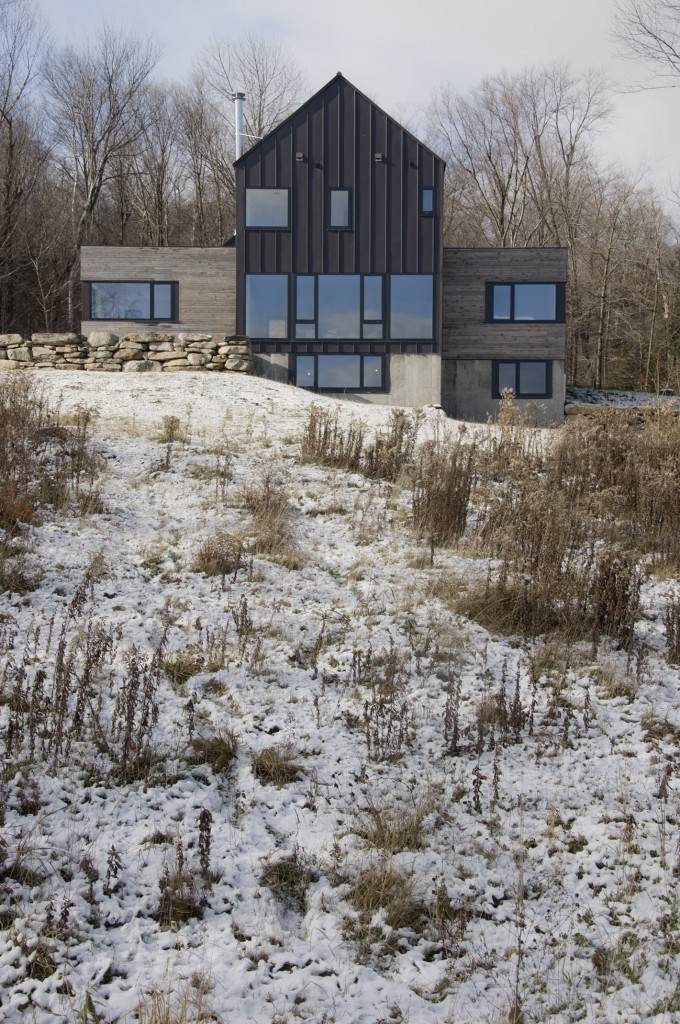
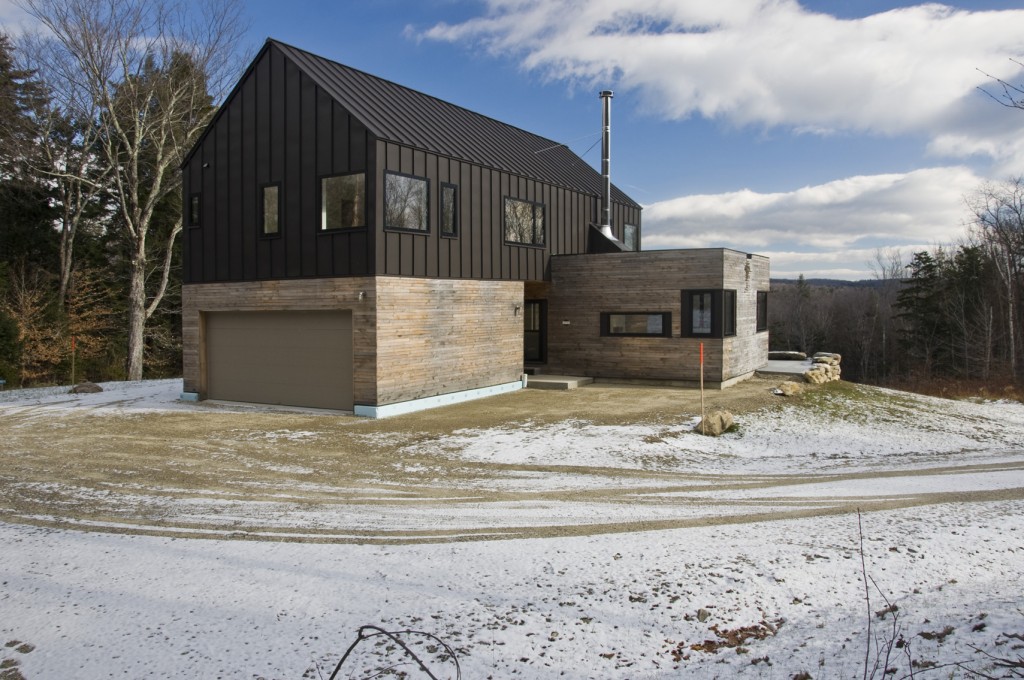
I had another comment recently from a builder who wants to build a house that breathes. I started to reply in an email and then decided to put it hereon the blog instead. What we are doing nowadays in the world of high performance homes is based on studying hundreds of thousands of houses built in the last half century that have failed (which includes the majority of 70's and 80's super-insulated and passive solar homes in the northeast) and applying those lessons to building a durable house nowadays. Houses from before that time period that failed for one reason or another are mostly gone and many of those that remain are simple piggy banks for big oil. We put our money in and the oil companies take it out. Simple. (usually, I like simple but...) For the past few decades, builders in the northeast have been living in a vacuum while the northern Europeans and Canadians paid much more attention to how houses fail, learning from them and adapting. Now the conversation is opening up again and we are taking a seat at the table.
I have lived in houses that breath my whole life. It sucks. Aside from the part where you have to give your money to someone else just to not freeze to death in the winter, there is the comfort aspect of things. Houses I have lived in have never been all that comfortable whether in terms of temperature or moisture levels or even wiping mildew off the window sills. Now, with two children, I worry about the air quality and mold issues inherent in my house that breathes. I would rather be able to seal up the house in the winter and be confident that I was breathing fresh Vermont air all the time than have to step outside for a breath of fresh air or open up the doors and windows if I screw up on getting the woodstove going. Six months out of the year, I would still have the choice to open the windows and turn off the HRV.
We do seem to have more summer moisture and humidity problems than we used to but we also have access to more durable and proven materials and building methods. Some builders and architects are taking advantage of this but most are building the same way they did 20 years ago despite all the failures. A house that breathes and has little or no insulation is a barn and If you want to heat it, that means coming to terms with giving your money away. Jesse Thompson says "People breath air through their lungs, not their skin. Why should houses be any different?" If you want your house to breathe, give it a set of lungs.
There are a range of options for doing this from exhaust only bathroom fans and range hoods (simple and cheap but where does the makeup air come from in a very tight house?) to a full-on Heat Recovery Ventilation System or HRV. These are also fairly simple and effective although significantly more expensive but have the added advantages of recovering much of the heat from the outgoing air as well as providing fresh incoming air exactly where you want it. For more information just type "HRV" or "house ventilation" into the search box on Green Building Advisor and start reading.
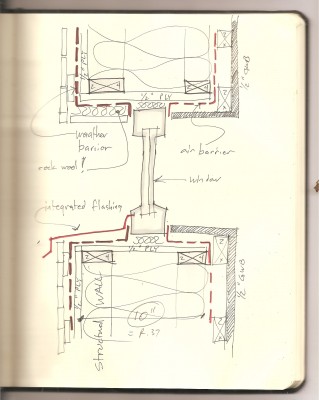 Designing a Super-insulated wall with good drying potential and good air sealing is easy. But the Devil is in the windows. With passive house level construction we want the window to be recessed toward the middle of the opening and the middle of the adjacent insulation layer. This is about thermal bridging and heat loss. An advantage that I've found is that it can potentially simplify the flashing which is certainly a welcome idea. Window and door installation has become increasingly complex over the past decade especially with exterior foam details. (I try to stay away from that) What I'm looking at in this sketch is how flashing for siding can be decoupled from flashing for the window to a great extent. Does the siding even need flashing anymore? Depends on how you do the siding. With some Rain screen siding details, perhaps not! Windows are now coming with really nice integrated sill flashing - you specify the depth when you order. This makes for a much more integrated and seamless system which should have long term durability advantages over what we have been doing up until now. What is missing from this drawing is an exterior layer of rock wool insulation to keep the sheathing warm (not rigid foam !) A more expensive detail and this may be less important when using cellulose than fiberglass insulation but is a detail I would certainly do on my own home. The other option is to use more of a Larsen truss system similar to what Chris Corson is doing in Maine with no exterior sheathing. It is A tough sell around here to leave the insulation protected only by a weather barrier such as Mento plus. The conversation on building science is terribly interesting and seems to be resolving itself towards simplicity as we gain knowledge and experience about what works and what doesn't and develop products and materials based on our increasing knowledge base. Of course, 93% of builders and architects aren't really paying much attention.
Designing a Super-insulated wall with good drying potential and good air sealing is easy. But the Devil is in the windows. With passive house level construction we want the window to be recessed toward the middle of the opening and the middle of the adjacent insulation layer. This is about thermal bridging and heat loss. An advantage that I've found is that it can potentially simplify the flashing which is certainly a welcome idea. Window and door installation has become increasingly complex over the past decade especially with exterior foam details. (I try to stay away from that) What I'm looking at in this sketch is how flashing for siding can be decoupled from flashing for the window to a great extent. Does the siding even need flashing anymore? Depends on how you do the siding. With some Rain screen siding details, perhaps not! Windows are now coming with really nice integrated sill flashing - you specify the depth when you order. This makes for a much more integrated and seamless system which should have long term durability advantages over what we have been doing up until now. What is missing from this drawing is an exterior layer of rock wool insulation to keep the sheathing warm (not rigid foam !) A more expensive detail and this may be less important when using cellulose than fiberglass insulation but is a detail I would certainly do on my own home. The other option is to use more of a Larsen truss system similar to what Chris Corson is doing in Maine with no exterior sheathing. It is A tough sell around here to leave the insulation protected only by a weather barrier such as Mento plus. The conversation on building science is terribly interesting and seems to be resolving itself towards simplicity as we gain knowledge and experience about what works and what doesn't and develop products and materials based on our increasing knowledge base. Of course, 93% of builders and architects aren't really paying much attention.
Sort ofThis is a schematic design for a local project I'm working on where I am doing master planning up front. See this post. After meeting with Gary MaCarthur to look at the whole site and master plan in terms of solar potential - the owners may, at least initially be "off the grid" - it was clear that the best locations for the house and barn were not so great for photovoltaics. Gary, like many other folks who design and install PV, like a clean simple installation, Ideally on the steeply pitched roof of a shed where the equipment can be housed. "a Power House". I knew the owners wanted to be able to spend weekends on the site year round and be comfortable and we had discussed building the barn first and finishing off the upstairs. Not a great solution unless you are prepared to build a fairly expensive barn as opposed to a pole barn for equipment and animals. Gary, upon listening to the master plan, long term build-out goals, suggested a cottage instead which could eventually become a guest house but in the meantime would serve as compact living quarters, the power house and storage for a tractor and whatever things get left here on a more permanent basis initially. being relatively small, a cottage could fit nicely into the overall site plan in a location ideal for photovoltaic panels.
As usual lately, I'm trying for the holy grail on this one and I hope the clients like the ideas. Holy Grail = Competitive cost Passive house priciples of low energy use, durable design and good building science local materials wherever possible and minimal environmental impact of materials Logical construction methods – nothing complicated or fancy Simple modern design – Scandinavian-ish? Clues from tradition but not a slave to it. - No Anachronism - use what works and eliminate frippery Texture and light and air Shadow and light. Intimately tied to the land. Seasonally adaptive and responsive Low maintenance – no or minimal exterior paint, stain , varnish – weathering materials and durable materials Emotionally uplifting space Proportion and grace.
Specifically to this project the long design seems to work best in terms of what we want to do with the site, the available roof for solar, the idea of layering, keeping the roof sheltering and low at the eave, build part now/part later if needed to get power set up, the gardeners cottage / gatehouse idea, overall simplicity, steep roof (Gary says to max winter gains) etc. I was also looking at cladding materials in more of a fabric sense with varying degrees of transparency which seems very Japanese and works very well for how I design wall systems.
Here is the initial sketch from my sketchbook:
Here are some photos from a recent project. This is an addition to a huge old barn which had a fairly recent Timberpeg addition to it. I did some work with the addition plus a larger new addition in a Greek Revival style with wrapping porches to create a more cohesive whole (and add a bunch of space) The addition is framed with double stud walls and super-insulated. Windows are triple glazed double hung. Fiber cement siding over rainscreen.Enjoy.
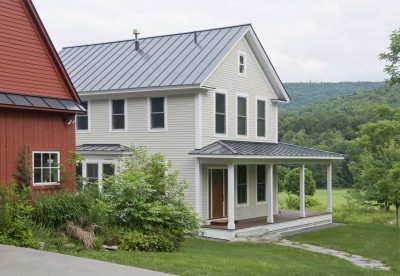
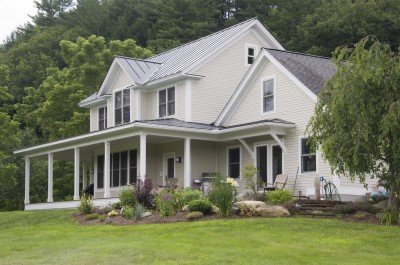
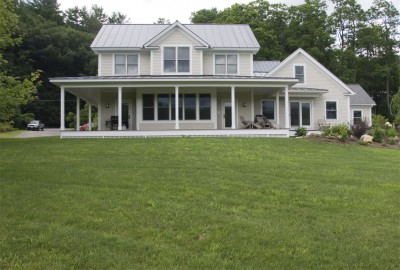
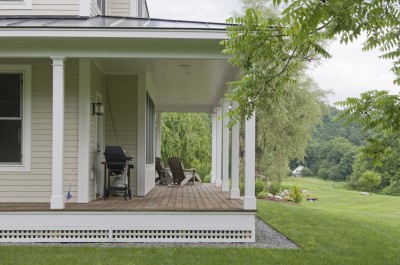
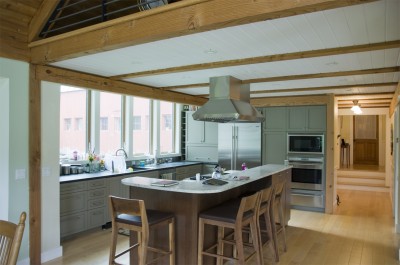
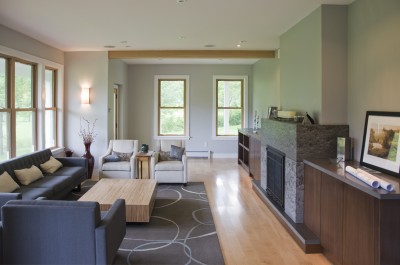 href="http://swinburnearchitect.com/wordpress/wp-content/uploads/2013/07/R1.jpg">
href="http://swinburnearchitect.com/wordpress/wp-content/uploads/2013/07/R1.jpg">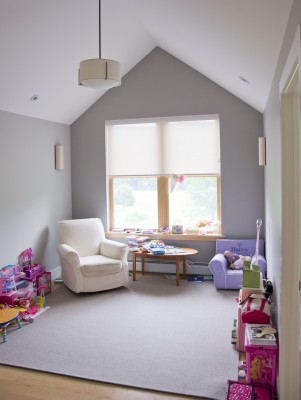
Some images from the model. Of course I don't think the clients can afford it but it's a good starting point. This is a one car garage with a studio space above it, a rear yard screen porch and a mudroom connecting all these. We can treat the addition as a separate unit from the existing house itself by building it to passive house standards and heating it (and cooling it) with a simple mini split heat pump. or we could ignore the cooling aspect and use a very small amount of electric heat.
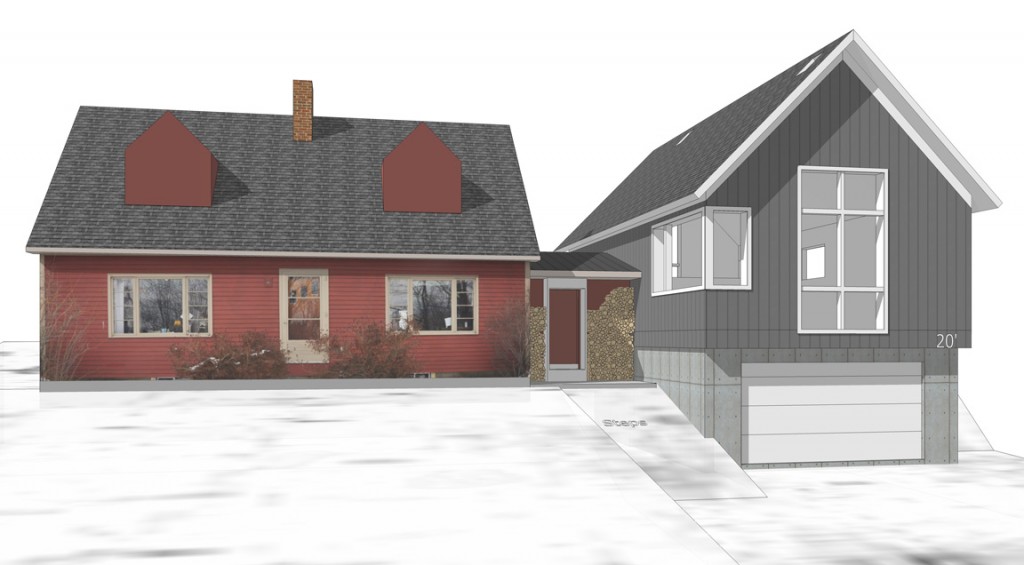
Apparently, although I never got an email, I am now a Certified Passive House Designer!!

What is Passive House ?
- The passive house standard represents the highest level of energy efficiency and “green building”. - The passive house standard is where state and municipality energy codes are headed. - Public housing groups such as Habitat for Humanity and regional housing authorities and land trusts are starting to require new housing units to be built to the passive house standard as these groups tend to prioritize overall cost of ownership over initial cost of construction. - The roots of Passive House trace back to the 1970s, when the concepts of superinsulation and passive solar management techniques were developed in the United States and Canada. - More than 25,000 buildings have been built to the Passive House standard in Europe. The standard is especially common in multi-family housing where it often makes little financial sense not to build to this level of energy efficiency.
Concept “Maximize your gains, minimize your losses”. These are the basic tenets of the Passive House approach. A Passive House project maximizes the energy efficiency of the basic building components inherent in all buildings; roof, walls, windows, floors and the utility systems: electrical, plumbing & mechanical. By minimizing a building's energy losses, the mechanical system is not called to replenish the losses nearly as frequently. This saves resources, operational costs and global warming related pollution. Unlike any other structures, Passive House buildings maintain occupant comfort for more hours of the year without the need for mechanical temperature conditioning of the indoor air. The opposite has been the norm in this country where we have a history of inexpensive fuel and construction techniques with little consideration for energy losses through thermal bridging, air-infiltration, and inadequate levels of insulation.
Passive House is both a building energy performance standard and a set of design and construction principles used to achieve that standard. The Passive House standard is the most stringent building energy standard in the world The Passive House approach focuses on the following:
Strategic Design and Planning: Passive House projects are carefully modeled and evaluated for efficiency at the design stage. Certified Passive House Consultants are trained to use the Passive House Planning Package (PHPP), a tool that allows designers to test “what-if” scenarios before construction begins. They are also trained to use other software tools to identify and address potential thermal bridges and moisture issues at the design stage. Specific Climate, Siting and Sizing: Passive House design uses detailed, specific annual weather data in modeling a structure’s performance. Orientation of the windows can maximize or minimize solar gain and shading. Passive House theory leans towards minimizing the surface area to interior volume ratio, favoring an efficient shape to minimize energy losses. Super-Insulated, Air-Tight Envelope (But Diffusion Open): To keep the heating/cooling in, wall assemblies require greater insulation values to “stop the conditioned air” from leaving. Walls are typically much thicker than today’s standard construction. Passive House takes great care in designing, constructing and testing the envelope for an industry-leading control of air leakage. Blower door testing is a mandatory technique in assuring high performance. Walls are designed to be virtually air tight, while allowing water vapor to dry out. “If moisture gets into the wall, how does it dry out before damage can occur?” is a fundamental tenet of modern building science addressed in Passive House design. Wall assemblies are analyzed to allow for proper water and moisture management to make a long lasting and an exceptionally healthy building. Thermal Bridge-Free Detailing: Breaks in the insulation layer usually caused by structural elements and utility penetrations in the building envelope create a “thermal bridge,” allowing undesirable exterior temperatures to migrate to and “un-do” expensive interior conditioned air and creating colder interior surfaces that encourage the growth of mold. Passive House design attempts to minimize thermal bridges via progressive mindful architectural detailing. Advanced Windows and Doors: Historically these items are the weak link of a building’s envelope and thermal defense system. Passive House places significant emphasis on specifying high performance windows and doors to address concern. To meet the high performance needs of various climate zones, windows must meet strict performance standards regarding: component insulation, air tightness, installation and solar heat gain values. Energy Recovery Ventilation: The “lungs” of a Passive House come from a heat (or energy) recovery ventilator (HRV/ERV). It provides a constant supply of tempered, filtered fresh air 24/7 and saves money by recycling the indoor energy that is typically found in exhaust air. The heat from outgoing stale air is transferred to the unconditioned incoming fresh air, while it is being filtered. It provides a huge upgrade in indoor air quality and consistent comfort, especially for people sensitive to material off-gassing, allergies and other air-borne irritants. HRV's are fast becoming standard equipment in all new houses in Vermont. Heating: One of the best benefits to implementing Passive House design is the high performance shell and extremely low annual energy demand. This allows owners to save on operational costs as they can now significantly downsize a building’s mechanical system. Passive solar gains, plus heat from occupants and appliances supply most of the needed heat. Radiant floor, baseboard, or forced hot air heating systems are unnecessary! Alternative Energy: Considering alternative energy systems on your project? Building to meet the Passive House Standard is the smartest starting point. The significant reduction in energy use, allows alternative energy to power a greater percentage of a buildings demands. Likewise smaller demand equates to smaller and more affordable alternative energy systems providing higher cost-benefit value. Passive House design puts a project within reach for achieving true “Net Zero” performance (the building generates as much energy as it consumes over the course of a year), making use of alternative energy systems smaller thus more affordable and attainable.
From Passive House Academy - I like the use of wine. It takes only two bottles of wine for a family of four.... or something like that. Just watch the video.
I visited the Stratton Project the other day to see how things were progressing. Flooring is going down (locally milled white oak) and plaster is going up. I'm very happy about the decision to plaster the walls on the main floor. The whole house inside and out is turning out to be a very tactile thing. The (experimental) rough hemlock siding on the exterior will weather to a soft grey and has the appearance of fabric, the plaster has just enough texture to do wonderful things with light in a way that a painted wall simply can't and the raw steel structural beams and posts provide a beautiful space defining element. The steel siding is actually "midnight bronze" which means it has a lot of color depth and can appear black in low light and shadow but really bursts forth in bright sunlight with the bronze undertone. Houzz.com has a lively discussion of black houses going on right now and lots of very strong opinions are being expressed! I have always loved black and dark houses. The more monochromatic the better. It speaks to the kid in me - I expect something more exiting from a dark house in a monsters under the stairs and witches in the attic way. With a modern looking project like this it's always interesting to see what the folks who work on it say. Some are completely sold and others not so much.
I completed Passive House Designer training after the design of this house and with my new level of knowledge of super-energy efficient construction, I would have done a few things differently perhaps but not much. At some point I will complete energy modeling on this project to see how close to the passive house standard we go.
Over the next few months the interior should be completed and I will post photos as things progress. The outside will look good for a while, then the snow will melt and it will look crappy until site work is completed.
Here is an example of a basic one-page-wonder construction drawing for a simple house. Not all the information is here to build a house but an expert builder can fill in missing details. For example, I put the stairs in the section with a very basic level of detail to make sure they work and meet code, however, I did not detail anything further than that. The stairs could be built in a very modern way with cable railings or very old fashioned with spindle ballusters and a newell posts. I concentrated on the overall aesthetic, proper Greek Revival details for the location and good building science practices with a very detailed double stud wall section from foundation to roof.
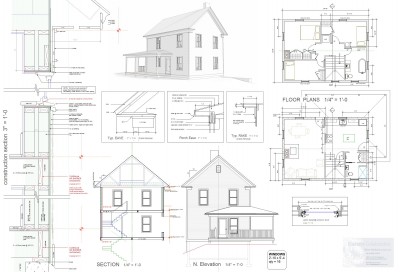
 I have competed the Passive House consultant/designer training and am almost ready to take the exam on Friday of this week. (eek!) Training consisted of 2 three-day sessions in Boston with instructors from Passive House Academy. There were 8 other people in my class including 5 architects, two people from European window companies and a person from an air exchanger company and I have to say that despite the difficulty and intensity of the material covered, we had fun. The instructors were Irish so, in the same way that I slip back into a Maine accent when I am talking to someone from Maine, I found myself speaking and even thinking with that lovely Irish flow. That lasted about a day and was somewhat annoying.
I have competed the Passive House consultant/designer training and am almost ready to take the exam on Friday of this week. (eek!) Training consisted of 2 three-day sessions in Boston with instructors from Passive House Academy. There were 8 other people in my class including 5 architects, two people from European window companies and a person from an air exchanger company and I have to say that despite the difficulty and intensity of the material covered, we had fun. The instructors were Irish so, in the same way that I slip back into a Maine accent when I am talking to someone from Maine, I found myself speaking and even thinking with that lovely Irish flow. That lasted about a day and was somewhat annoying.
The course and the training is relatively new and evolving. The content of the course is all about creating super low energy use buildings using highly vetted building science. The concept is based on these 5 fundamental principles:
-Very high levels of insulation -Avoiding thermal bridges -Using high performance (and very nice and very expensive) windows and doors -Airtight construction (lots of detailing and testing to insure air-tightness) -Controlled mechanical ventilation with heat-recovery
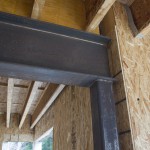 Example of Structural Steel with no thermal bridging
Example of Structural Steel with no thermal bridging
This is all familiar stuff to any builder or architect who is paying attention these days but Passive house goes beyond the current codes to where codes will be in 10 to 20 years. This is passive solar design from the 70's brought to the highest levels. It is no longer experimental but based on sound physics, a huge data base of existing projects, an understanding of moisture and air quality issues. It is also very much based on simplification. We have a huge understanding of how buildings work and how they fail so Passive House is all about using that knowledge to create buildings that succeed. For a great primer on Building science check out the Summer 2012 issue of Fine Homebuilding which you may still be able to pick up on newstands. There is an article by Kevin Ireton entitled “The Trouble With Building Science.
The economics of building to the Passive House standard are very persuasive. So persuasive that housing groups around this country including Habitat for Humanity and public housing developers are taking notice. They already took notice in Europe of course and are building many housing projects to using Passive House principles. Schools are a particularly important application of Passive House design because of air quality in particular. When you add long term operating and maintenance costs, energy costs, decreased liability issues etc. to the initial building costs, it is hard to imagine building any other way. In Europe the banks are taking notice of this as well in terms of favorable lending rates.
A big selling point is air quality and the durability of buildings. The current state of building in the U.S. is fairly dismal. Even most building and energy codes are based on a rather half-assed interpretations of building science. We have been creating buildings that are too complicated, cost too much to maintain, have air quality issues due to a number of factors often involving mold and other moisture and air quality related problems.
So the six days were spent looking at proven projects including many retrofits, studying and understanding details and products as well as overall design approach (very 70's solar) understanding the economic issues, covering mechanical systems, understanding how buildings succeed or fail, and diving into the basic physics of it all.
An example would be: If you add x amount of insulation or upgrade the windows to a more expensive, better performing model, how much less heat will you need to pump into the building in the winter and cooling in the summer thereby saving heating and cooling costs? And not only that but can you get the heating and cooling needs low enough so that you can spend less money up front on a simpler and cheaper heating system? [note: with Passive House design, radiators -if you even need them -don't need to be under windows] And are surface temperatures in the room such that moisture will not condense on cooler surfaces in corners due to thermal bridging? - something that becomes hugely important when you super-insulate.
I really appreciate the whole concept of doing it right the first time as well as the focus on simplification. (Anyone who has looked into the mechanical room of a building built in the past thirty years should understand the need for simplification) I also appreciate that Passive House goes into a deeper level of common sense “green” than net-zero, LEED, Energy Star and all other certification type programs – some of which are rather laughable. I will repeat myself from a previous blog entry before I started this whole Passive House thing: “If the Shakers were still building, they would be building passive Houses!”
I am working on this new small greek revival in Maine. Not the high style Greek Revival with huge columns like you see on banks and government buildings but the small, simple style that is so ubiquitous in New England and doesn't get much attention but everybody knows. I'm designing it to "pretty good house" standards. It is for a family member who lost her house in a fire- we'll see how the budget goes and if the details get watered down as is often the case. She has always loved the Greek Revival look which is more often done wrong than right it seems. I used this sketchup model to push and pull and play with trim and proportion to get it right. I have found that often the frieze board (the wide flat board at the top of the siding under the eaves) often gets shortchanged when the builder frames the house including window openings then discovers that he doesn't have enough room for a properly proportioned frieze.

In any design there is always a lot of back and forth on windows - what works inside may not be so great on the outside etc. so I use the model to really fine tune it in terms of balance, rhythm, symmetry/asymmetry (exterior aesthetics) and light, cross ventilation, views, sun and solar gain, the feel of the room, (function and interior aesthetics)
This is very different from this house which is currently under construction in Vermont which is also a "Pretty Good House" although nearly to the Passive House with Unilux triple glazed windows from Germany But with a modern aesthetic and some really beautiful spaces and materials. We are using raw green 1 x 3 hemlock from a local mill at siding over coravent strapping (rain screen detail) and Mento 1000 weather barrier. The hemlock will dry in place, turn grey and gap in a rougher version of open joint siding often created with Ipe or cedar siding.
I am also studying and reviewing the first three days of Passive House training. The next three days are coming up next week. I am learning a lot of building science stuff that will improve the level of design and service I am able to provide - whether or not I ever get to work on a certified passive house. It was disconcerting, however, to ride the bus into Boston past thousands upon thousands of older houses and housing stock that is rather the opposite of Passive House in terms of energy usage and all the other metrics. You get the feeling of "what's the point". Is passive house a just another trophy for someone building a new house to attain and meaningless in terms of saving ourselves from the coming death, doom and destruction of climate change? I am looking at it in terms of simply building better houses and not thinking about saving the world.
"No matter how many times you save the world, it always manages to get back in jeopardy again. Sometimes I just want it to stay saved, you know? " - Mr Incredible.
Passive House New England SymposiumSaturday, October 27th I went to the Passive House New England Symposium to see what's what so to speak. I came a way with lots of good information about where to take my own practice, where the state of the art in building science is at, currently, in New England, who is involved with Passive House, how Passive House technology is being used and what my next steps as an architect will be.
Update November 12: Martin Holladay's review on Green Building Advisor Passive House is a performance based standard of energy use in a building. It really is the gold standard and very hard to achieve. It goes far beyond current energy codes but represents where most (residential at least) energy codes will be within 20 years. It focuses on measurable standard of quality, high levels of air-tightness and high levels of insulation – and there is a very big focus on air quality. In these areas it goes much more to the heart of the matter than LEED and most of the other “green building” certification programs. All these issues are worked out in the planning phase with the Passive house planning software (PHPP) along with other geeky software programs and verified during the construction process with multiple blower door tests, for instance. The end result is not necessarily a more expensive building, especially when you add in a few years worth of fuel costs that you won't have. I like the simplicity of the approach.
This is from Passive House New England: Passive House is the world’s leading standard for energy efficient construction. It combines building enclosure efficiency and passive solar strategies in a system for designing and building cost effective, comfortable, energy efficient buildings. In the New England climate, the major components are: Super-insulated envelope Ultra-high-performance windows Eliminating or reducing thermal bridging Airtight construction (0.6 ACH@50Pascals)* Heat-recovery ventilation Using passive heat sources (solar of course, but also equipment, lighting, and occupants).
The roots of Passive house were in the United states in the 70's with all the “Mother Earth News” folks. Lots of mistakes were made back then but the Germans took notice and carried it forward. This is passive solar perfected.
The Conference was a who's who of leaders in the green building field which was encouraging and lent legitimacy to the passive house concept. The level of discussion was exactly what I had hoped for. There was real criticism about the place of Passive house principles in single family housing. So often these types of events can be just a bunch of like minded Architects wearing black and stroking each others egos. It seems that the real value of passive house is holding it as the gold standard which may not be achieved on every project and that's okay. The whole passive house approach is based on sound building science and simplicity. So often, green building is all about gadgetry - if you read and believe the magazines. The passive house approach is more about simplifying. If the Shakers were still building, they would be building passive Houses! The passive house standard is actually rather arbitrary. The whole idea is to be able to make financial decisions based on sound science. The standard is often used to reach a point where the heating system of a building can be achieved with a mini-split heat pump - which can also provide cooling. Once you eliminate the boiler, radiant floor heating etc., you're golden! Money saved!! Score one for simplicity.
Many of the projects we went through in the presentations were not actually up to the Passive house standard. But Passive House principles and the actual software (PHPP) were used to inform the decision making process in the design phase of all these projects. It was great to see the care and concern of builders and architects – and developers in creating such high quality projects. Passive House is not just about levels of insulation, it is really all about measurable, verifiable quality.
Getting back to my own practice, I intend to go through the passive house training - nine days of classes and an exam which will result in my become a certified passive house consultant and designer. This will allow me to offer a higher level of service to my clients, create better projects, be a part of a great community, and generally stay at the highest and farthest to the right end of the curve. I'm feeling very good about things right now.
Toward the end of the day Marc Rosenbaum of Energysmiths (and one of the aforementioned gurus) made a “plea for beauty” which was a nice to hear. (That's where I come in)
Construction is underway on this super insulated modern house in Vermont where we are trying out some very cool things.

Siding for instance. The lower siding is 1x3 green hemlock, unfinished from a local mill over insect screen over coravent strapping over Solitex mento 1000 building wrap from 475 supply over Vantem Sips..
The Solitex is a beautiful product, black and with UV protection which allows for an open gap siding treatment. I spec'd 1x3 local green hemlock because it is beautiful to work with when green, will shrink and gap in place as it dries and turn gray, The individual pieces are somewhat irregular so the overall effect is like a fabric. Very sexy and at a fraction of the cost of some other wood sidings. Hemlock is a very durable wood when left to weather. When I was a teenager working in a sawmill in Maine we cut a lot of hemlock to build a bridge over the crooked river. I also used it for much of the framing for my barn and I have many staging planks of hemlock. Because it is untreated all waste can be burned as kindling, or even tossed into the bushes to provide habitat for red backed salamanders. The photos show the window holes boarded up in preparation for the coming storm. I was there the day the glorious windows from Unilux were delivered. Next up: installing the windows - a very different affair than the standard American window with flanges.
Chris Corson, a builder in Maine working in the Passive House arena used raw pine in a similar fashion on this neat little project
From Martin Holladay on Green Building Advisor in an artivle titled "Occupant Behavior Makes a Difference" Engineer things all you want but when you put Americans into a house the metrics tend to change. This is pretty funny.
It didn’t take long to figure out what was driving the high energy bills. “There is a very large plasma TV, plus a second TV on the porch,” said Panish. “There is a DVR. The two TVs and the DVR use 600 watts when they're on and 100 watts when they are off, and the TVs are on for an average of 6 hours per day. The loads for entertainment and computers are high. There is an old freezer in the basement. There is a basement dehumidifier. The lighting load is 600% of what was predicted. It seems as if all the lights in the house are left on all the time.”
CLOG - the complete construction log for Tiny house.Caleb and Laura kept a CLOG or Construction Log for their tiny house in Brattleboro. Plans for it are for sale on HousePlans.com
What follows is a discussion from Bluetime Collaborative's Facebook page. For those of you who don't know, Bluetime is Vermont Architect. It represents the increasingly collaborative nature of running a small architecture business.
Bluetime Collaborative: I just attended a mini seminar at Building Green with Peter Yost on wall and roof systems - moisture management. something of a recap for me but what I think about are how many architects and builders are still doing things the way they were 10 or 20 years ago.
Bluetime Collaborative: I think what I got out of it was that we need to think more in terms of systems rather than simply products. There is a huge amount of information and discussion out there that most builders and architects are ignoring at their own peril.
Bluetime Collaborative: Remember building is a science, codes represent bare minimums and are always ten years behind the science, r-value is but a small part of a system
Dave: Bob, what is their wall/roof system recommendation?
Bluetime Collaborative: it boils down to air and moisture management and dealing with them as separate issues. ideal systems may differ from practical systems. (what would you do on your own house -vs-what would you design for someone else to build. Always know where your dew point will be to prevent failures. (LOTS of failures in the northeast in recent years) walls need to dry to the inside and outside. Air condiitoning introduces a whole new set of parameters. Boston based Building Science Corp is a good place to start. Insulation is what you add when everything else is done right. Systems management means there are tons of great and products out there and tons of hype, but little knowledge of how to put them all together as a system to minimize risk. Have a lawyer design your details ;-) they will research the science and design no minimize risk. Or design like a lawyer...
Dave: What's the current though on closed-cell foam? I like what it does for creating a very tight envelope but question what happens when water works its way into the wall. Open cell scares me - I have seen it blacken with mold because of infiltration at a roof.
Bluetime Collaborative : worth further investigation I would check greenbuildingadvisor.com - I have been lucky to never have used open cell. I hear it isn't great. I have used closed cell in a flash and batt situation often. It works very well with my double stud wall system and has lots of advantages. The key seems to be to flash thick enough so the dew point doesn't happen at the sheathing and look at the overall wall in terms of how it can dry out. (always assume things will get wet) For instance; vinyl wallpaper doesn't allow for drying to the inside.
Dave : Fine Homebuilding just had an article on the flash and batt approach. I was apprehensive when I read it thinking it would only be marginally more to fully spray the walls. I'm hoping to do closed cell on our house but it will come down to a budget decision.
Bluetime Collaborative: Flash and batt is usually cheaper enough to make the decision clear. A timing advantage in the fall is that you can flash, then all the subs do their thing in a warm heatable environment then fill in right before sheetrock. Probably the best performing system involves 2" of rigid outside (depending on where you live) with cellulose inside but detailing is tough - learning curve. Window manuf. are now adding exterior jamb extensions to their options.
Dave: I've seen that exterior insulation detail in Building Science Corp's books but have never done it before. Flash and cellulose is an interesting combination.
Matt : Bob, which window manufacturers? Thermotec? Also, this is a killer blog entry. I'm not buying flash & batt at all, especially with less than 2" flash coats; flash & pack ... maybe... better continuity, fewer gaps, between the lumpy foam and the cellulose than batts. I can't agree more on the theme of systems over products. I do construction estimating for a building supply company. I see 8-10 plans a week. The scariest thing I see right now is a la cart use of new products without regard to the system.
Matt: Actual construction document examples: taped 1" XPS over taped ZipWall with 5" cavity OPEN CELL, continuous Grace Ice & Water shield over closed-cell rafter bay insulation (Grace has even published a report advising against this), and 9" rafter bay closed-cell under a flat roof (mostly egregious because there are a dozen known more practical ways to deal with that).
Bluetime Collaborative: yikes!
Bluetime Collaborative: I should clarify and perhaps my terminology is wrong. By "Batt" I do mean a blown in dense pack cellulose or even fiberglass not batts. Does anybody use those anymore? (sarcasm)
Bluetime Collaborative: When I look back over the past ten years at my own work I see an interesting progression from 2 x 6 walls with fiberglass batts, poly vapor barrier and no questions asked to now where each house I do is a bit different and I spend much time investigating the options including what I can sell to the owner and what the contractor will actually build as well as what the budget will allow.
Dave: Bob - What is your "ideal" wall and roof system?
Bluetime Collaborative: as of today or what will it be next week? performance wise all foam on the outside with an empty 2 x 4 wall cavity inside.
Bluetime Collaborative: practical (cost /benefit analysis) double 2 x 4 stud 8 to 10" deep with 1 1/2" foam outside taped. up and over the roof if possible too.
Dave: With that much foam outside how to you detail door and window penetrations economically?
Bluetime Collaborative: that was my ideal performance scheme - not cost effective or very easy to detail. you see it sometimes on European passive house projects, often with the windows set to the inside face of the wall for increased thermal performance. Practical is 1 1/2" xps foam outside, (1" doesn't get the dew point out of the sheathing) and dense pack cellulose in the cavity. The question then becomes whether to set the windows and doors to the sheathing or block them out to the outside of the foam and strapping. (complicated layering and flashing) fortunately some window manufacturers are addressing this as I mentioned before with exterior jamb extensions. I also have a detail to allow an inswing exterior door to be mounted to the outside but still open nearly all the way. You can see it in the "Tiny House Plan for Sale"
Matt: Dave, if you want to see details on the 'all outside the wall' insulation plan you can download the REMOTE wall manual or look into the Canadian PERSIST method.
Matt: http://www.cchrc.org/
Bluetime Collaborative: foam on the outside works to get the dew point away from the sheathing but what about the ability of the wall to dry to the outside? I still have too many questions. I'm going to find a building scientist, knock him down and sit on his chest until he (or she) tells me what to do.
I hear you on that. One question: how do you figure out where dew point occurs for various times of the year within a wall?
Bluetime Collaborative : I think they look at the average temperature for the three coldest months (I could be wrong) because if the dew point occurs before the sheathing, water condenses on the sheathing itself and ices up rather than drying out. This is often a p...See More
Rui : good chat! With IBC 2009, the exterior wall design comes into question FINALLY, but only because the R-value is bumped up to 20 or (13+5). With the very first opportunity we had, we went with batt stud cavity R-13 insulation and R-5 continu...See More
Bluetime Collaborative : In VT and much of northern New England only 1" of ext foam puts the dew point in the sheathing too much of the time (rot issues) so we go with 1 1/2 to 2". Nominal vs actual doesn't seem to make it into codes either. a 2 x 6 wall with fib...See More
Rui: well that was exactly my next set of comments, the codes only go so far. Understanding the wall technology is more important than prescribed R values.
Bluetime Collaborative: reading...reading....
Dave: This is going to make a great blog post. I've been thinking about the wall section you sent for the last few days. I've also been thinking about this at a time where I'm detailing my own house. It's giving me a headache.
Bluetime Collaborative: Luckily we have GBA which has really become The on stop shop for learning. When I go to seminars for cont ed. it is all repeats of the discussions on GBA. Feel free to add questions you have, Environmental Building News is 1/2 mile away from my office - I have some contacts. http://www.energysmiths.com/ - Marc Rosenbaum is an excellent resource as well.
Dave: I'm scared of what the answers could be but I'm wondering about red cedars (non-rainscreen) over Zip System with closed cell poly (2x6 construction) and no vapor permeable membrane and an interior of veneer plaster. This is our standard wall these days...
Rui?:"Vaproshield" barrier
Bluetime Collaborative : vaproshield is an excellent product and what you use for an open rainscreen. I would look seriously at a rainscreen detail even just bumpy tevek type stuff. Rainscreen detailing is becoming code in parts of this country and if you did wood siding in some northern euro countries without rainscreen, they would look at you like you had two heads. I think the cedar works in your favor. We sometimes use New England white cedar from our local mill.
Greg: I am really not enthusiastic about the addition of low perm foam in thick layers to a wall system. Once you do this, you reverse to a drying to the inside wall system, and now suddenly every micro-climate needs to check the dew point location of their wall configuration to avert a disaster. To me this just does not make sense. A dry to the outside wall system is something that works over a wide climate range, and if AC is introduced, a smart vapor retarder like Membrain allows you to balance the drying performance for the summer.
Bluetime Collaborative: I'm starting toward the no foam on the outside idea as well. simply due to the drying thing. A local builder is liking Membrane and I tagged it elswhere for further study. We are lucky in VT as only people from out-of-state who build houses here seem to want A.C. We do seem to have extended very wet times (like now) every summer. I keep coming back to my oversimplified double stud wall for simplicity and low cost and excellent thermal performance. I've done it 1/2 doz times so far with different builders so the kinks are mostly worked out. Think of the inside 2 x 4 wall as just another interior wall.
This is typical of the conversation that goes on in the industry. Gregory La Vardera chimed in with this: "my opinion is the Building Sciences guys are brilliant, but rather insensitive to the practical side of what is easy or difficult, or even preposterous, to do in a house project. Even for a one of a kind custom show-off how energy efficient we can be house they can be a little over the top - never mind something we expect to be widely adopted across the entire housing industry." With which I would largely agree although I have found the building science folks around here seem to have a lot of practical knowledge gained from working closely with builders. LaVardera also linked me to a series of posts on his website detailing how the Swedes do things. If you go there, check out how they do windows - it's very cool. The swedes also don't do basements Grumpy architect alert: (Americans need basements because Americans have so much stuff) but have very nice foam slab forms that seem to have a durable cementitious outside surface rather than having to attach something to protect the foam afterwards. The Swedish system is built as much as possible in a factory which happens very little in the U.S. other than low cost modular type housing. There seems to be a big hump to get over in terms of creating factory built custom housing at a competitive price point. Also the Swedes don't seem to be afraid of Modern design. Perhaps that is also an American "thing"